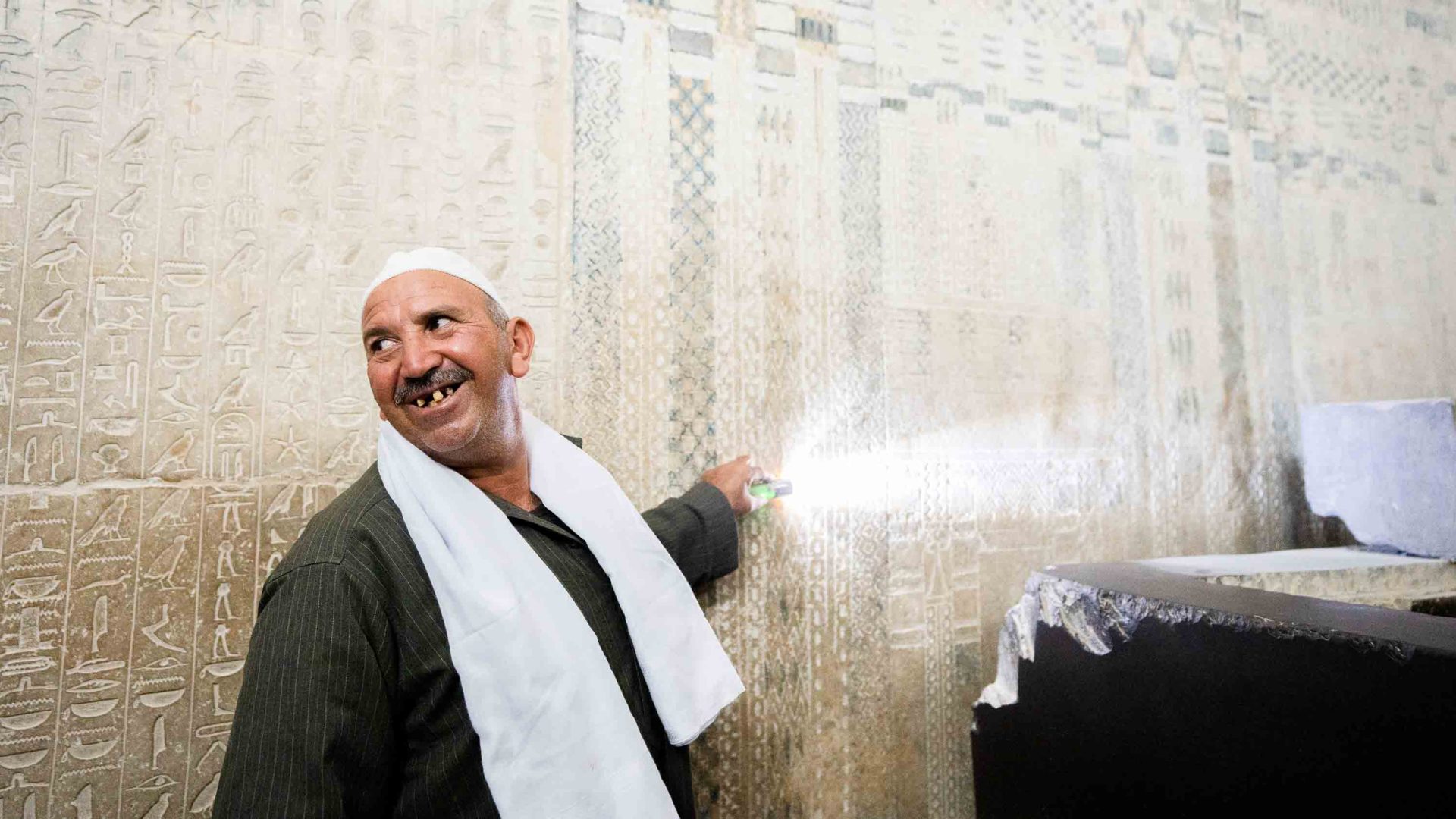
While tourists flock to the Pyramids of Giza, the nearby Saqqara Necropolis offers a less crowded, alternative Ancient Egypt experience. Not to mention the oldest surviving pyramid in the world. Egypt-based writer Tamara Davison explores.

While tourists flock to the Pyramids of Giza, the nearby Saqqara Necropolis offers a less crowded, alternative Ancient Egypt experience. Not to mention the oldest surviving pyramid in the world. Egypt-based writer Tamara Davison explores.
The entrance narrows as, one by one, we descend deeper into the pyramid. We crouch and shuffle along the tunnel shaft like eager adventurers, the coolness of the enclosing walls contrasting the blazing desert temperatures outside.
Exploring the inside of a 4,000-year-old burial chamber in an ancient Egyptian pyramid is not for the faint-hearted—nor for those who aren’t fond of small spaces. But, then again, venturing to the final resting place of a once-famed Egyptian ruler is worth a little discomfort.
King Unas’ remains and treasures have long since been looted, but what’s left is unlike anything I’ve ever seen. Above us, a canopy of engraved blue stars, and around us, the walls decorated, top to bottom, with intricate hieroglyphs, carefully designed to help the king enter the afterlife. I almost can’t believe these vivid colors, once masterfully selected by skilled ancient artists, have survived so long.
The Saqqara Necropolis, just south of Cairo, is a cooler and less crowded alternative to Egypt’s Great Pyramids of Giza. What I mean by this is it feels less curated and more authentic: Instead of battling crowds and selfie sticks, there are fewer barriers here between you and history. King Unas’ awe-inspiring 4,300-year-old tomb is just one of many spectacular burial sites that make the historic location undoubtedly worth the day trip.
Here, far from the heckling vendors and throngs of tourists of Giza, you’ll find pyramids that predate their more famous counterparts and uncover intriguing ancient mysteries that baffle leading historians even to this day.
This colossal pyramid—dating back to the 27th century BC—is the oldest surviving pyramid in the world, and a great start to any tour of Saqqara.
“Giza is more like a photo stop,” Egyptologist Seham Gabr tells me, highlighting the difference between Saqqara and the Giza complex faintly visible in the distance. When I joined the Ancient Egyptian expert for a walking tour, I soon discovered that Saqqara feels more immersive—and not just because the site predates Giza by several centuries.
Saqqara served as the burial ground for the ancient Egyptian capital of Memphis and has a complex of impressive pyramids and tombs. Like Giza, there are lots of photo-worthy views here, but what sets Saqqara apart is the deeper level of connection and understanding to the site’s ancient life.
Rising 203 feet (62 meters) from the sand and towering above the leafy forests of date palms beyond, the Step Pyramid of Djoser is the first structure that confronts visitors at the necropolis. Built by the famed ancient architect Imhotep (who apparently did lend his name to The Mummy franchise), this colossal pyramid—dating back to the 27th century BC—is the oldest surviving pyramid in the world, and a great start to any tour of Saqqara.
Made of six limestone platforms in a step-like formation, this pyramid was essentially a prototype for the rest of Egypt’s world-famous tombs and marked a turning point in the legacy of Ancient Egyptian rulers.
Walking around its base is an imposing, silent reminder of the cultural significance of this region. Djoser’s pyramid has withstood the test of time—surviving earthquakes, revolutions, and the scorching desert elements, in true testament to the ingenuity of Ancient Egyptian architects.
Looking out across the vast sandy desert, like countless archaeologists have done before me, I wonder—what more is there to discover here?
After admiring the pyramids, we push on to the mastabas, an array of smaller yet equally phenomenal tombs brimming with hieroglyphic carvings and colors so bold they could have been painted yesterday.
“Seeing the paintings, the colors, the carvings inside the noble tombs, it’s so magnificent,” says Gabr. “It always leaves the tourists speechless.” And she isn’t wrong. As we meander through the tombs, I’m confronted at each turn with more and more astonishing 4,000-year-old reliefs. You won’t find these at Giza.
The scenes—not protected behind glass or guarded from tourists—make the ancient history feel strikingly tangible with depictions of everyday activities, such as sleeping, fishing the Nile, and preparing food. Other reliefs are more curious, like a figure carrying a hedgehog in a box (an odd choice of pet in Ancient Egypt, I feel) and a man kissing a pig. Subtle imperfections, like overdrawn corners and missed hieroglyphics, add a touch of humanity, and bridge the gap between the lives of the ancients and us.
“If the pyramids of Giza are one of the seven wonders above the ground, then the Serapeum at Saqqara is one of the wonders under the ground. You cannot imagine or explain how they managed to carve these kinds of tunnels under the ground.”
- Seham Gabr, guide and Egyptologist
In the hidden tomb of Maya, a vivid yellow façade seems to leap from the wall as we clamber from yet another dark tunnel. Delicate details, like black eyeliner in the classic Egyptian style, frame the gaze of figures whose eyes follow us around the mastaba.
Gabr points out the signatures of ancient artists and places where the figures had been scrubbed from the carvings after betraying the Pharaoh. She explains that the direction of hieroglyphic figures instructs the reader on which way to interpret the symbols; her understanding of ancient languages helps bring these walls to life.
Saqqara is also home to the Serapeum, a giant complex of tunnels that once housed a collection of bull mummies enclosed in 24 enormous granite sarcophagi. Historians believe these bulls were worshipped in homage to an Egyptian deity called Apis, symbolizing strength, fertility, and the living manifestation of the god Ptah. Once each bull died, they were mummified and worshipped in the Serapeum—a site that was active for over 1,000 years.
As we venture deeper into this once-sacred space, you can feel the energy in the air and the centuries of history it housed. However, many questions, particularly around how these tunnels were built, remain unanswered.
The echoing tunnels are vast, precisely carved, and clearly a phenomenal accomplishment for ancient engineers. “If the pyramids of Giza are one of the seven wonders above the ground, then the Serapeum at Saqqara is one of the wonders under the ground,” Gabr says. “You cannot imagine or explain how they managed to carve these kinds of tunnels under the ground.”
Modern experts also can’t agree on how the tunnels were created, nor how each 70-tonne sarcophagus (each made of a single piece of granite) was brought underground. Modern efforts to remove the sarcophagi have proved amusingly fruitless—with one sarcophagus now left stuck close to the entrance, eternally blocked by a corner.
As we emerge from the Serapeum, returning to the dizzying brightness of the Egyptian sunshine, my aching legs signal that the walking tour has been a success. There’s so much left to discover, but that just gives me all the more reason to return. And soon.
The fact that 70 percent of the Saqqara Necropolis is yet to be excavated only adds to my excitement—there’s so much potential for future archaeological discovery. And it’s probably happening as you read this.
Just weeks ago, archaeologists uncovered the tomb of a doctor believed to have treated the pharaoh himself, and I can only imagine how overwhelmed one would feel to be the first to see such a brightly colored tomb in over 4,000 years. At the beginning of our tour, Gabr described Saqqara as “one of the most important places in Egypt.” And after today, I definitely believe this to be true.
**
The writer joined Seham Gabr’s walking tour of Cairo’s Ancient Egyptian sites.
****
Adventure.com strives to be a low-emissions travel publication. We are powered by, but editorially independent of, Intrepid Travel, the world’s largest travel B Corp, who help ensure Adventure.com maintains high standards of sustainability in our work and activities. You can visit our sustainability page or read our Contributor Impact Guidelines for more information.
Tamara Davison is a freelance journalist from the UK who has been published in The Guardian, The Times, and The Independent. For the last eight years, she's traveled the world, seeking out the planet's most adventurous and off-beat destinations. Now based in the Middle East, she covers foreign affairs, humanitarian stories, culture, travel, and the environment.


Can't find what you're looking for? Try using these tags: